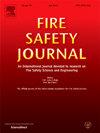消防员头盔的辐射性能:颜色和烟尘沉积对热性能的影响
IF 3.4
3区 工程技术
Q2 ENGINEERING, CIVIL
引用次数: 0
摘要
本文研究了消防员头盔的热辐射性能,重点研究了头盔颜色和烟尘沉积对其性能的影响。消防员的头盔通常是镀铬的,以提高反射率,或者是彩色的,以提高可视性,在操作过程中,头盔在防止辐射热方面发挥着关键作用。通过红外光谱测量,分析了各种头盔的定向半球反射率和吸收率,评估了头盔颜色和表面条件等因素。结果表明,镀铬头盔能反射大部分辐射热(1000 K时平均反射率为83%),具有较好的热防护效果。相比之下,彩色头盔的反射率降低,从3%到14%不等,导致辐射吸收增加。镀铬头盔(被烟灰和燃烧产物覆盖)的反射率下降到约36%,这突出了定期清洁以保持热防护的重要性。这些发现促进了对头盔类型之间热性能差异的理解,有助于提高消防员的安全性,并为未来头盔设计的考虑提供了见解。本研究收集的所有实验数据均可在开放获取数据库中获取,以供进一步使用。本文章由计算机程序翻译,如有差异,请以英文原文为准。
Radiative properties of firefighter helmets: Effect of color and soot deposition on thermal performance
This study investigates the thermal radiative properties of firefighter helmets, focusing on the influence of helmet color and soot deposition on their performance. Firefighters’ helmets, often chrome plated for reflectivity or colored for functional visibility, play a critical role in protecting against radiant heat during operations. Through infrared spectrum measurements, this work analyzes the directional-hemispherical reflectivity and absorptivity of various helmets, assessing factors such as helmet color and surface conditions. Results indicate that chrome plated helmets reflect most of the radiative heat (average reflectivity of 83% at 1000 K) providing superior thermal protection. In contrast, colored helmets show reduced reflectivity, ranging from 3% to 14%, resulting in increased radiative absorption. Helmets, covered by soot and combustion products), demonstrate a reflectivity drop to approximately 36% for a chrome plated helmet, highlighting the importance of regular cleaning to maintain thermal protection. These findings advance the understanding of thermal performance differences among helmet types, contributing to improved firefighter safety and offering insights into future helmet design considerations. All experimental data collected in this study are available in an open-access database for further uses.
求助全文
通过发布文献求助,成功后即可免费获取论文全文。
去求助
来源期刊

Fire Safety Journal
工程技术-材料科学:综合
CiteScore
5.70
自引率
9.70%
发文量
153
审稿时长
60 days
期刊介绍:
Fire Safety Journal is the leading publication dealing with all aspects of fire safety engineering. Its scope is purposefully wide, as it is deemed important to encourage papers from all sources within this multidisciplinary subject, thus providing a forum for its further development as a distinct engineering discipline. This is an essential step towards gaining a status equal to that enjoyed by the other engineering disciplines.
 求助内容:
求助内容: 应助结果提醒方式:
应助结果提醒方式:


